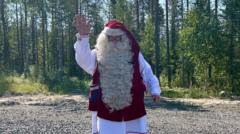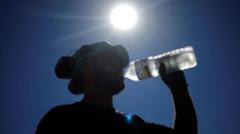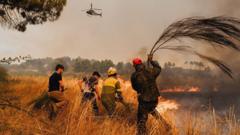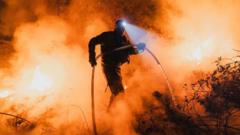As temperatures in Lapland reach uncommon highs, Santa Claus finds himself instructing his elves on the importance of hydration to stave off sunstroke in the midst of a historic heatwave. Northern Finland has been grappling with remarkable warmth, with temperatures consistently around 30°C. In contrast to his typical winter routine, Santa has opted to remain indoors, donning lighter attire and only venturing out for cooling swims in the evening.
The city of Rovaniemi, where Santa's workshop is based, is facing this unusual weather with surprising resilience. However, scientists attribute the unusual warmth in the Arctic to climate change. Following an unexpectedly chilly spring, the region has entered a prolonged cycle of high temperatures, with the ongoing heatwave expected to last 15 days by July 25.
Finnish Meteorological Institute meteorologist Jaakko Savela highlighted the rarity of such heatwaves in Lapland, noting that the last comparable occurrence was in 1972, lasting up to only two weeks. Record temperatures of 31.7°C were observed at various locations including Ylitornio and Sodankylä.
This alarming trend of unusual heatwaves highlights the broader implications of climate change, as the Arctic is warming at an accelerated pace—four to five times faster than the rest of the globe. While Savela states that the heatwave itself wasn't caused directly by climate change, he emphasizes that its severity is influenced by it.
Professor Jeff Weller from the University of Oulu echoed this concern, acknowledging that even if the heatwave weren't directly linked to climate change, such phenomena are now commonplace due to the fundamental shifts in climate systems worldwide. He warned of the likely increase in frequency and intensity of heatwaves.
Reindeer, a cherished symbol of the region and essential to Santa's story, are also affected by the rising temperatures, forced to seek relief from the oppressive heat and swarms of pesky mosquitoes. As their natural habitats become inhospitable, reindeer herders may soon have to construct shelters for their animals to protect them from the extreme weather.
Tourists flocking to Lapland, traditionally seeking a cool retreat, are puzzled by the extreme heat, grappling with unexpected high temperatures. Many visitors, like Silvia from Prague, express disappointment and discomfort, having packed for what they anticipated to be a much cooler trip, underscoring the rapidly changing climate dynamics in the region.
For many, including Santa and his elves, this heatwave raises pressing questions about the future of Lapland’s winters and the implications of enduring extreme weather patterns. Santa, for one, yearns for the return of snow-laden winters, longing for the frosty embrace that defines his most iconic season.

















